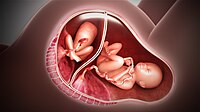Twin reversed arterial perfusion

Imagine two babies growing inside their mother's womb, sharing one placenta that gives them nutrients and oxygen. In a normal pregnancy, both babies get the blood supply they need through their own arteries, and there is no mixing of blood between them. However, sometimes something goes wrong, and one of the babies develops an abnormality called Twin Reversed Arterial Perfusion (TRAP) sequence.
TRAP happens when one of the babies, called the "pump twin," has a normal arterial system that pumps blood through its body and into the shared placenta. However, the other baby, called the "recipient twin," does not have its own functioning arteries. Instead, it relies on the pump twin's arteries to supply its body with blood. This causes an abnormality because the blood flows in the opposite direction than normal. The recipient twin's vein pumps blood into the pump twin's artery, and the pump twin's heart works harder to pump blood for both of them.
This situation can cause a variety of problems for both twins. The recipient twin doesn't get enough oxygen because the blood it receives is not oxygenated enough. As a result, its organs may not develop properly, and it may even die without proper treatment. On the other hand, the pump twin's heart has to work extra hard to supply blood to both its own body and the recipient twin, which can cause heart failure in extreme cases.
Doctors can diagnose TRAP by using ultrasound to monitor the babies' growth and blood flows through the placenta. Treatment options depend on the severity of the condition and how far along the pregnancy is. In some cases, doctors may suggest a procedure to selectively reduce the blood flow to the recipient twin to prevent further complications. In other cases, doctors may recommend an early delivery or even fetal surgery to address the underlying cause of the condition.
Overall, TRAP is a rare and serious condition that requires close monitoring and medical intervention to ensure the best possible outcome for both twins.
TRAP happens when one of the babies, called the "pump twin," has a normal arterial system that pumps blood through its body and into the shared placenta. However, the other baby, called the "recipient twin," does not have its own functioning arteries. Instead, it relies on the pump twin's arteries to supply its body with blood. This causes an abnormality because the blood flows in the opposite direction than normal. The recipient twin's vein pumps blood into the pump twin's artery, and the pump twin's heart works harder to pump blood for both of them.
This situation can cause a variety of problems for both twins. The recipient twin doesn't get enough oxygen because the blood it receives is not oxygenated enough. As a result, its organs may not develop properly, and it may even die without proper treatment. On the other hand, the pump twin's heart has to work extra hard to supply blood to both its own body and the recipient twin, which can cause heart failure in extreme cases.
Doctors can diagnose TRAP by using ultrasound to monitor the babies' growth and blood flows through the placenta. Treatment options depend on the severity of the condition and how far along the pregnancy is. In some cases, doctors may suggest a procedure to selectively reduce the blood flow to the recipient twin to prevent further complications. In other cases, doctors may recommend an early delivery or even fetal surgery to address the underlying cause of the condition.
Overall, TRAP is a rare and serious condition that requires close monitoring and medical intervention to ensure the best possible outcome for both twins.
Related topics others have asked about:
